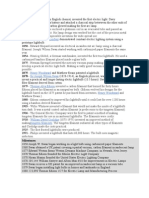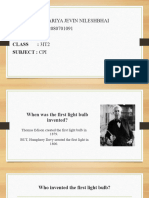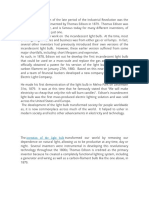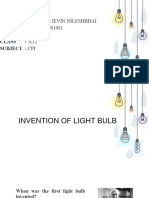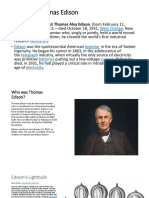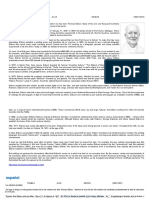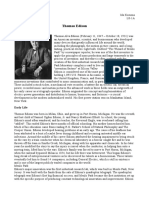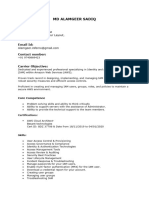Light Bulb: Thomas Edison
Light Bulb: Thomas Edison
Uploaded by
KingCopyright:
Available Formats
Light Bulb: Thomas Edison
Light Bulb: Thomas Edison
Uploaded by
KingOriginal Title
Copyright
Available Formats
Share this document
Did you find this document useful?
Is this content inappropriate?
Copyright:
Available Formats
Light Bulb: Thomas Edison
Light Bulb: Thomas Edison
Uploaded by
KingCopyright:
Available Formats
Light Bulb
Thomas Edison
Throughout the nineteenth century, inventors produced simple electric lights. For example,
Joseph Swan produced a simple electric light, but, he struggled to maintain a power source and the
filament soon burned out when the vacuum was exhausted. It was Thomas Edison who made the light
bulb into a practical low current version. He used a filament based on a burned sewing thread.
In 1878, Thomas Edison began serious research into developing a practical incandescent
lamp and on October 14, 1878, Edison filed his first patent application for "Improvement in Electric
Lights”. However, he continued to test several types of material for metal filaments to improve upon his
original design and by Nov 4, 1879, he filed another U.S. patent for an electric lamp using "a carbon
filament or strip coiled and connected ... to platina contact wires.”
The electric light, is one of the everyday conveniences that most affects our lives, was not
“invented” in the traditional sense in 1879 by Thomas Alva Edison, although he could be said to have
created the first commercially practical incandescent light. He was neither the first nor the only person
trying to invent an incandescent light bulb. In fact, some historians claim there were over 20 inventors of
incandescent lamps prioXr to Edison’s version. However, Edison is often credited with the invention
because his version was able to outstrip the earlier versions because of a combination of three factors: an
effective incandescent material, a higher vacuum than others were able to achieve and a high resistance
that made power distribution from a centralized source economically viable.
Thomas Alba Edison’s mastermind guided to this amazing invention that changed the world.
With the electrification of the modern world, the light bulb invented in the year 1879 profoundly changed
human life by illuminating the night. The first electric bulb made it possible for all human lives hospitable
to a wide extent of modern day activities. However, it is assumed that the idea behind the light bulb came
from Humphrey Davy in the 1800, when he invented an electric battery and connected a carbon with
wires which glowed and produced electric arc. Edison improvised the concept of Joseph Wilson Swan
and Charles Francis Brush experimenting with different filaments that could last longer. Edison started
with a 40-hour life light bulb and finally made a bulb that lasted for 1500 hours. The incandescent bulb is
revolutionizing human lives since then.
Although the patent described several ways of creating the carbon filament including using
"cotton and linen thread, wood splints, papers coiled in various ways," it was not until several months
after the patent was granted that Edison and his team discovered that a carbonized bamboo filament could
last over 1200 hours. This discovery marked the beginning of commercially manufactured light bulbs and
in 1880, Thomas Edison’s company, Edison Electric Light Company begin marketing its new product.
You might also like
- The Last Days of NightDocument6 pagesThe Last Days of Nightwamu88567% (3)
- Incandescent and FlourescentDocument83 pagesIncandescent and FlourescentArniel SomilNo ratings yet
- History of The Light BulbDocument1 pageHistory of The Light BulbMarc AmpilanNo ratings yet
- History of The Light BulbDocument2 pagesHistory of The Light BulbYeoz MadrigalNo ratings yet
- A Brief History of The Light BulbDocument4 pagesA Brief History of The Light BulbNo Mi Vi100% (2)
- Light BulbsDocument7 pagesLight BulbsVBNLOVNo ratings yet
- History of Incandescent and Flourescent LampDocument1 pageHistory of Incandescent and Flourescent Lampbhokzhy0704No ratings yet
- The Development of The LightbulbDocument2 pagesThe Development of The LightbulbPhượng TạNo ratings yet
- History of The Light BulbDocument6 pagesHistory of The Light BulbDaniel RaeNo ratings yet
- Warren de La RueDocument1 pageWarren de La RueElke RadistyaNo ratings yet
- Light BulbDocument13 pagesLight BulbFurious ZouhairNo ratings yet
- Lightbulb EssayDocument2 pagesLightbulb Essayapi-313451943100% (1)
- The Invention of The Light BulbDocument10 pagesThe Invention of The Light BulbMinh Quân Nguyễn ĐăngNo ratings yet
- The Development of The LightbulbDocument2 pagesThe Development of The Lightbulbayeshastudies888No ratings yet
- CPI PresentationDocument7 pagesCPI Presentationffire0502No ratings yet
- Henry WoodwardDocument2 pagesHenry WoodwardElla Mae Militar GalesNo ratings yet
- Thomas Alva EdisonDocument7 pagesThomas Alva EdisonDavid SolisNo ratings yet
- Light BulbDocument1 pageLight BulbNaomi HernandezNo ratings yet
- History Incandescent LampDocument3 pagesHistory Incandescent LampMARK JOSHUA CONDEZA GARCIANo ratings yet
- Information Sheet BulbDocument9 pagesInformation Sheet BulbRex Chambers LadaoNo ratings yet
- Thomas Edison and the Invention of the Light Bulb: Separating Fact from FictionFrom EverandThomas Edison and the Invention of the Light Bulb: Separating Fact from FictionNo ratings yet
- English Project B6Document5 pagesEnglish Project B6Mateo XXXNo ratings yet
- CPI PresentationDocument11 pagesCPI Presentationffire0502No ratings yet
- The Light BulbDocument7 pagesThe Light BulbvanessacavadianaNo ratings yet
- Edison's LightbulbDocument3 pagesEdison's LightbulbAxyle NoqueraNo ratings yet
- History and Development of Incandescent LampDocument11 pagesHistory and Development of Incandescent LampstajuanalawrenceNo ratings yet
- Evolution of A Light BulbDocument10 pagesEvolution of A Light BulbKula Segara PandiyanNo ratings yet
- The Light Bulb: Arianna CurielDocument5 pagesThe Light Bulb: Arianna CurielariannaNo ratings yet
- Thomas EdisonDocument2 pagesThomas EdisonCarlo Fernando Padin100% (1)
- Black and Yellow Light Bulb Electrician Business CardDocument8 pagesBlack and Yellow Light Bulb Electrician Business Cardmaria toledoNo ratings yet
- Thomas Edison: Created by Tomas Ragauskas and Eidvilė Ažusienytė 2cDocument14 pagesThomas Edison: Created by Tomas Ragauskas and Eidvilė Ažusienytė 2cTomas RagauskasNo ratings yet
- Light BulbDocument14 pagesLight BulbKimberly Cyreene CantosNo ratings yet
- PC2 - 2017-1 - AntenasDocument7 pagesPC2 - 2017-1 - Antenaspedro7127 pedro7127No ratings yet
- Uncle John Bathroom EdisonDocument3 pagesUncle John Bathroom EdisonRobert SmithNo ratings yet
- Incandescent Light BulbDocument21 pagesIncandescent Light BulbNayan MannaNo ratings yet
- TungstenDocument10 pagesTungstenshreyanshusbeheraNo ratings yet
- Alfred Nobel and Thomas Edison Jhon Paul - ElidaDocument2 pagesAlfred Nobel and Thomas Edison Jhon Paul - Elidajhon paulNo ratings yet
- Bulb AssignmentDocument2 pagesBulb AssignmentJamie McGregorNo ratings yet
- Thomas Edison Research PaperDocument7 pagesThomas Edison Research PaperlilmissswaggaajNo ratings yet
- Homas Alva Edison: Early LifeDocument3 pagesHomas Alva Edison: Early LifeVishal DhekaleNo ratings yet
- The Filament Is Enclosed in A Bulb To Protect The Filament FromDocument1 pageThe Filament Is Enclosed in A Bulb To Protect The Filament Fromadrija bNo ratings yet
- Incandescent Lamp Slide ShareDocument32 pagesIncandescent Lamp Slide ShareDaniel SampagaNo ratings yet
- A Brief History of Light - WIRED PDFDocument3 pagesA Brief History of Light - WIRED PDFRear BaueltazarNo ratings yet
- Carbon TelephoneDocument2 pagesCarbon Telephonejacobges42No ratings yet
- Elec 2 SDocument1 pageElec 2 SNurul Atikah ShafieNo ratings yet
- Thomas Alva EdisondosDocument4 pagesThomas Alva EdisondosdonblasNo ratings yet
- Hostory of ElectricityDocument2 pagesHostory of ElectricityChris ChanNo ratings yet
- Thomas Alva Edison: (Invention of The Light Bulb)Document4 pagesThomas Alva Edison: (Invention of The Light Bulb)nurqasseh1991No ratings yet
- Assgt1 Idakusuma InventorDocument3 pagesAssgt1 Idakusuma Inventorai_eiNo ratings yet
- Thomas Edison The Incandescent Light BulbDocument1 pageThomas Edison The Incandescent Light BulbGaebrielle Mialouise MagadiaNo ratings yet
- Thomas EdisonDocument2 pagesThomas Edisonapi-219149054No ratings yet
- Elec 3 IDocument1 pageElec 3 IKriixstel Anne AbadNo ratings yet
- Escuela Josefina Sagrada Familia: Teacher: Óscar VíquezDocument6 pagesEscuela Josefina Sagrada Familia: Teacher: Óscar VíquezPáez SáenzNo ratings yet
- Thomas Alva Edison (February 11, 1847 - October 18, 1931) WasDocument5 pagesThomas Alva Edison (February 11, 1847 - October 18, 1931) WasAbdullah HamidNo ratings yet
- XDIAK SƏRBƏST İşDocument20 pagesXDIAK SƏRBƏST İşSukur BagirovNo ratings yet
- PDF 20230104 135135 0000Document15 pagesPDF 20230104 135135 0000Hiba Zizi100% (1)
- J1587 SIDs All OthersDocument24 pagesJ1587 SIDs All OthersJose Armando Miranda VelascoNo ratings yet
- Earth and Life Science: Quarter 1 - Module 10: Movements of Plates and Formation of Folds and FaultsDocument24 pagesEarth and Life Science: Quarter 1 - Module 10: Movements of Plates and Formation of Folds and FaultsRhy cabanes123100% (7)
- Ground Improvement Technique - Grouting Technology (For Irrigation Projects and Tunnelling)Document109 pagesGround Improvement Technique - Grouting Technology (For Irrigation Projects and Tunnelling)Sumanth GundetiNo ratings yet
- INVERTERvacon NXSPIN-07Document24 pagesINVERTERvacon NXSPIN-07Mohd Abu AjajNo ratings yet
- Regression Exercise 4Document3 pagesRegression Exercise 4Boy MicroNo ratings yet
- TKT-CM-01-OM-1060-I-R1-O&M Manual - Control & Monitoring System PDFDocument144 pagesTKT-CM-01-OM-1060-I-R1-O&M Manual - Control & Monitoring System PDFThái Đức NhơnNo ratings yet
- Vacation Assignment (Chemistry) XIDocument12 pagesVacation Assignment (Chemistry) XIRaju SinghNo ratings yet
- Introduction To AIOps - SimplilearnDocument14 pagesIntroduction To AIOps - SimplilearnAmarNo ratings yet
- Michael "Scott" Simmons: Phone # 918 894-2730Document3 pagesMichael "Scott" Simmons: Phone # 918 894-2730scott simmonsNo ratings yet
- Eucharistic Prayer IIIDocument6 pagesEucharistic Prayer IIIJERONIMO PAPA0% (1)
- Chapter 2 - Gradually Varied Flow (GVF)Document16 pagesChapter 2 - Gradually Varied Flow (GVF)Obsi Naan JedhaniNo ratings yet
- MD Alamgeer SadiqDocument5 pagesMD Alamgeer Sadiqalamgeer.infernoNo ratings yet
- NP NCP DHFDocument6 pagesNP NCP DHFfairwoodsNo ratings yet
- Samsung Galaxy Ace Duos S6802 - User Manual Download PDFDocument142 pagesSamsung Galaxy Ace Duos S6802 - User Manual Download PDFDaniela FlorescuNo ratings yet
- SP4T SP5TDocument178 pagesSP4T SP5TPriyanka DwivediNo ratings yet
- Reaction Paper On The Movie of PK: Nhor Ivan Yap. Cuartero Ma'am Lovely BenemiliDocument4 pagesReaction Paper On The Movie of PK: Nhor Ivan Yap. Cuartero Ma'am Lovely BenemiliNhor Ivan Y. CuarteroNo ratings yet
- Samovar Chapt 1Document15 pagesSamovar Chapt 1jeyleooagungNo ratings yet
- Acute GlomerulonephritisDocument32 pagesAcute GlomerulonephritisEzekiel moraraNo ratings yet
- KOLLAM (Outlook)Document27 pagesKOLLAM (Outlook)Mohammed MusthafaNo ratings yet
- IELTS Writing Book Thay Mike - Collected by Ielts-Nguyenhuyen-TrangDocument155 pagesIELTS Writing Book Thay Mike - Collected by Ielts-Nguyenhuyen-TrangNguyên Nguyễn Ngọc ThảoNo ratings yet
- Multiple Trading Price List 2023Document16 pagesMultiple Trading Price List 2023rubelNo ratings yet
- Equipment Specialist Series: United States Office of Personnel ManagementDocument22 pagesEquipment Specialist Series: United States Office of Personnel ManagementAbdel Nasser Al-sheikh YousefNo ratings yet
- Case PresentationDocument39 pagesCase PresentationAnni BarbaNo ratings yet
- Soal Bahasa Inggris KLS 5Document4 pagesSoal Bahasa Inggris KLS 5Niko pratamaNo ratings yet
- MSI Confidential 00205363 RD (C) 2020111202 劉巍 (30001789) : Dp + Dp + Dp + Hdmi/Dp PG142-B00Document55 pagesMSI Confidential 00205363 RD (C) 2020111202 劉巍 (30001789) : Dp + Dp + Dp + Hdmi/Dp PG142-B00hiệp nguyễn văn (văn-hiệp-pc)No ratings yet
- Business Ethics AssignmentDocument11 pagesBusiness Ethics AssignmentDiptimoy TripuraNo ratings yet
- Precalculus: Senior High School Grade 11Document28 pagesPrecalculus: Senior High School Grade 11Gerlie Jay-ann RamosNo ratings yet
- Qac 084Document13 pagesQac 084ANTONIO MARTINEZNo ratings yet
- Components of Health Related Fitness LONGDocument6 pagesComponents of Health Related Fitness LONGClark NuevoNo ratings yet
- Chief Seattles Speech STD 9 and 10Document4 pagesChief Seattles Speech STD 9 and 10SukanshiNo ratings yet












